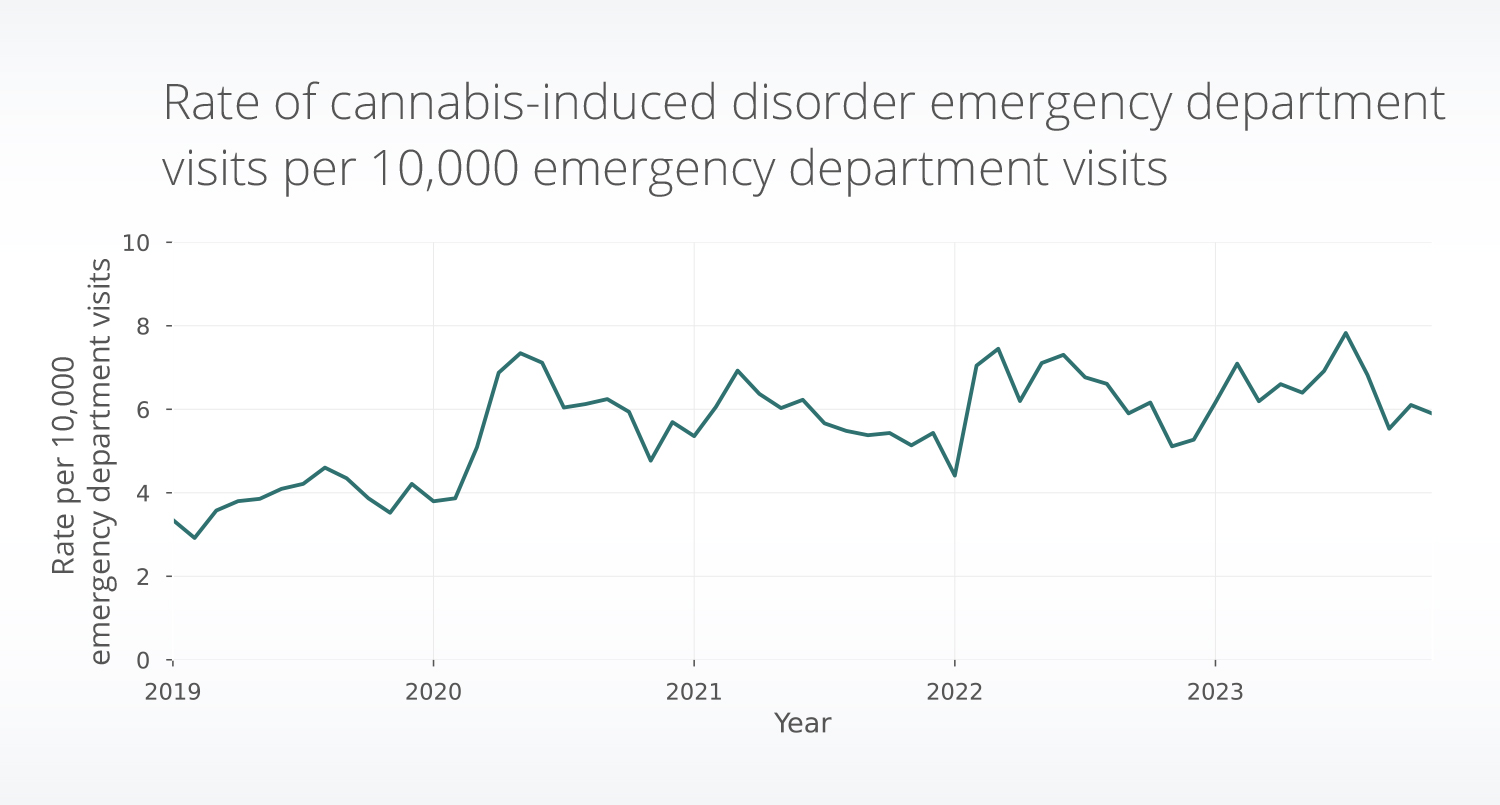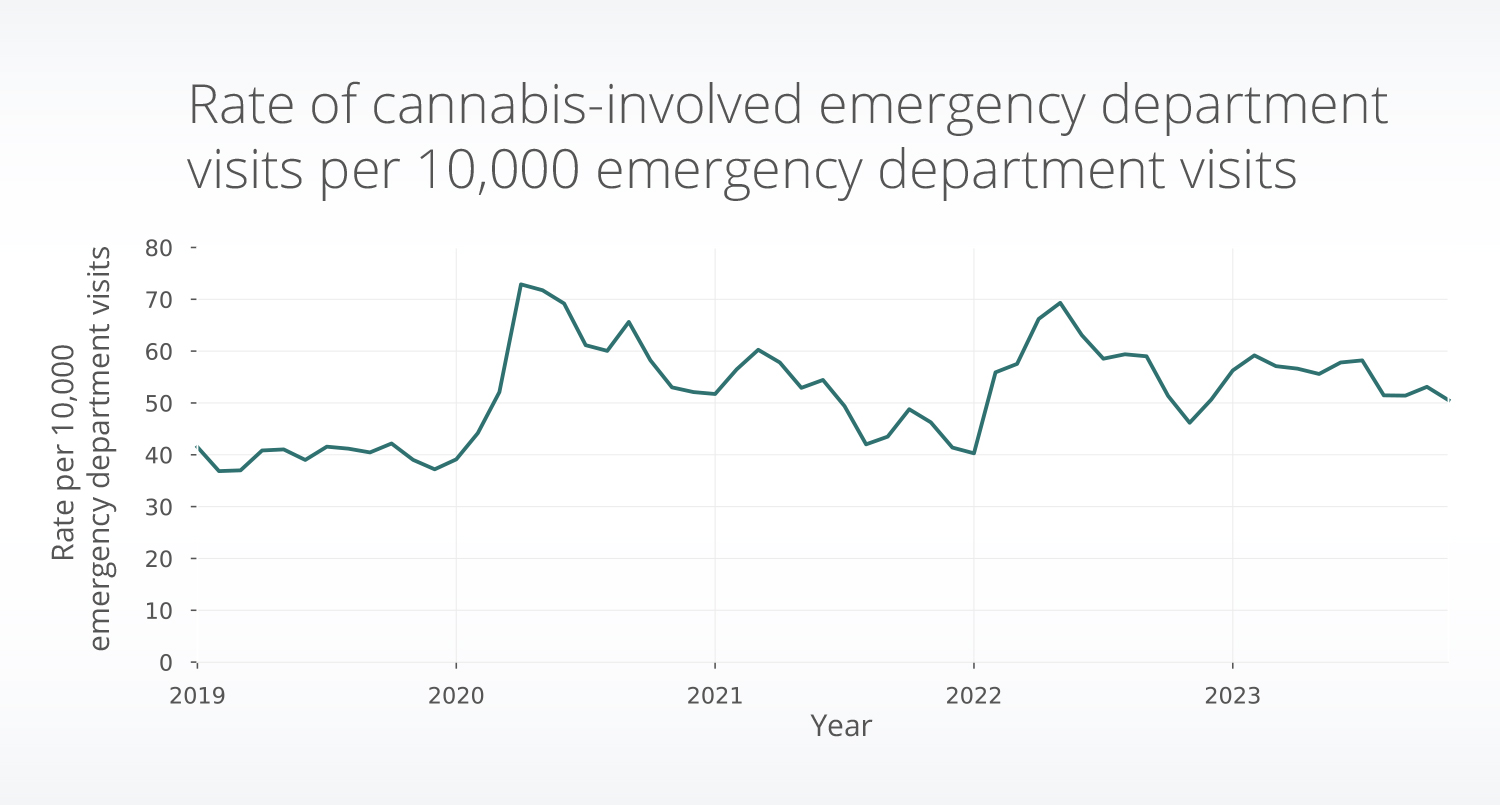- There is a complex relationship between cannabis use and mental health. We studied recent time trends of the rate of cannabis-induced disorder emergency department visits and cannabis-involved emergency department visits (both defined below).
- Between 2019 and 2020, we found a nearly 50% increase in the rate of both cannabis-induced-disorder emergency department visits and cannabis-involved emergency department visits. The rate of cannabis-induced disorder emergency visits continued to increase through 2023, while these trends were not seen with the cannabis-involved emergency department visits.
- Our study highlights the need for additional research to understand the populations most at risk and if these have shifted over time.
In light of the enduring challenges posed by the pandemic and its profound implications for our well-being, the legalization and expanding acceptance of cannabis in numerous states offer a unique perspective on potential therapeutic interventions. Medical use of cannabis first became legal in California in 1996 to help patients with medical treatment recommended by a physician (University of California, Hastings College of the Law, 1996). Since then, states have expanded their approval to assist patients with both physical and mental health conditions. As of January 1, 2024, medical cannabis is legal in 39 states, and recreational cannabis is now legal in 25 states (Malyshev & Ganley, 2024).
There is a complex relationship between the use of cannabis and mental health disorders (National Institute on Drug Abuse, 2023). People with mental health-related illnesses are more likely to use cannabis (Rup et al., 2021); however, cannabis has also been linked to earlier onset of mental health-related illnesses, such as schizophrenia (Arseneault et al., 2004). More research is needed to fully understand the connections between mental illness, cannabis use, and mechanisms of action.
With the increase in psychological distress since the onset of the pandemic, we aimed to study if there were also increases in cannabis-induced disorder emergency department visits. These are mental or behavioral health disorders associated with cannabis use. We also studied trends in cannabis-involved emergency department visits, which are more broadly defined by the CDC to capture general disorders associated with cannabis use and abuse (Roehler et al., 2023). We found the rate of cannabis-induced disorder emergency visits has risen nearly 50% between 2019 and 2020 and continues at elevated levels. We also found that the rate of cannabis-involved emergency department visits rose nearly 50% between 2019-2020 and remains elevated compared to 2019 data but has fluctuated in rates since 2020.
Methods
We calculated the monthly rate of cannabis-induced disorder emergency department visits and cannabis-involved emergency department visits per 10,000 emergency department visits. The rates were calculated separately; a visit could be included as both a cannabis-induced disorder emergency department visit and cannabis-involved emergency department visit in a given month. However, for each measure, people were only counted once per month, even if they had more than one emergency department visit. We also calculated the year averages and percent increase in rates between years.
Results
Cannabis-induced disorder emergency department visits
The 2019 rate of cannabis-induced disorder emergency department visits per 10,000 emergency department visits was 3.9±0.5 and increased 46.2% to 5.7±1.2 in 2020. The rates remained elevated and continued to increase to 6.5±0.6 through the end of the study period.

Cannabis-involved emergency department visits
The 2019 rate of cannabis-involved emergency department visits was 39.8±1.9 per 10,000 emergency department visits. We saw a 46.5% increase to the 2020 rate (58.3±10.7); however, we do not continue to see increases in more recent years (2021 rate: 50.4±6.3, 2022 rate: 56.5±8.3, 2023 rate: 55.2±3.0).

Discussion
Across the US, there are varying laws and perspectives about the use of cannabis – both recreationally and for medical use. Various states, political groups, or age groups may be affected by these conditions differently and therefore have varying rates, although we did not study this here. The CDC studied cannabis-involved emergency department visits and found an increase among kids under ten and between 11-14 years of age (Roehler et al., 2023). The rates in this study are similar, but slightly lower, likely due to the difference in populations studied (an overall population in this study versus a pediatric population in the CDC study).
As with any study, this study has some limitations. First, if a person had multiple emergency department visits in a single month, they were only counted once. Therefore, we could be undercounting both the total number of cannabis-related emergency department visits and/or the emergency department visits. Second, we did not study a causal relationship between cannabis use and mental health. As previously mentioned, a complex relationship exists here, and we only studied time trends related to diagnosis codes. Additionally, we did not distinguish between people using cannabis medically or for recreational use. Finally, we did not include lab tests to show the presence of cannabis; we relied on physicians’ diagnoses.
The observed surge in cannabis-induced disorder emergency department visits and the absence of sustained trends in cannabis-involved emergency department visits underscore the intricate nature of the relationship between cannabis use, mental health, and healthcare utilization. While our study sheds light on recent trends, the varying perspectives and legal landscapes across the US necessitate a more nuanced exploration of how different populations may be affected. This study also emphasizes the importance of ongoing research to enhance our understanding of the multifaceted dynamics surrounding cannabis use and its implications for public health.
These are preliminary research findings and not peer reviewed. Data are constantly changing and updating. These findings are consistent with data accessed on December 19, 2023.
References
Centers for Disease Control and Prevention. (2022, March 31). New CDC data illuminate youth mental health threats during the COVID-19 pandemic. https://www.cdc.gov/media/releases/2022/p0331-youth-mental-health-covid-19.html
Malyshev, A., & Ganley, S. (2024, January 9). With 2023 in rearview mirror, what should the cannabis industry expect in 2024? https://www.reuters.com/legal/litigation/with-2023-rearview-mirror-what-should-cannabis-industry-expect-2024-2024-01-09/
Marin, D., Di Gennaro, G., Baracetti, M., Zanetti, R., Balestrieri, M., Cogo, P., & Colizzi, M. (2023). Confirmation of increased and more severe adolescent mental health-related in-patient admissions in the COVID-19 pandemic aftermath: A 2-year follow-up study. Psychiatry Research Communications, 3(2), 100119. https://doi.org/10.1016/j.psycom.2023.100119
National Institute on Drug Abuse. (2023). Is there a link between marijuana use and psychiatric disorders? https://nida.nih.gov/publications/research-reports/marijuana/there-link-between-marijuana-use-psychiatric-disorders
Pasquini, G., & Keeter, S. (2022). At least four-in-ten US adults have faced high levels of psychological distress during COVID-19 pandemic.
Roehler, D. R., Smith, H., Radhakrishnan, L., Holland, K. M., Gates, A. L., Vivolo-Kantor, A. M., & Hoots, B. E. (2023). Cannabis-Involved Emergency Department Visits Among Persons Aged <25 Years Before and During the COVID-19 Pandemic—United States, 2019–2022. MMWR. Morbidity and Mortality Weekly Report, 72(28), 758–765. https://doi.org/10.15585/mmwr.mm7228a1
Rup, J., Freeman, T. P., Perlman, C., & Hammond, D. (2021). Cannabis and mental health: Prevalence of use and modes of cannabis administration by mental health status. Addictive Behaviors, 121, 106991. https://doi.org/10.1016/j.addbeh.2021.106991
Salari, N., Hosseinian-Far, A., Jalali, R., Vaisi-Raygani, A., Rasoulpoor, S., Mohammadi, M., Rasoulpoor, S., & Khaledi-Paveh, B. (2020). Prevalence of stress, anxiety, depression among the general population during the COVID-19 pandemic: A systematic review and meta-analysis. Globalization and Health, 16(1), 57. https://doi.org/10.1186/s12992-020-00589-w
University of California, Hastings College of the Law. (1996). Voter Information Guide for 1996, General Election (pp. 58–61). https://repository.uclawsf.edu/cgi/viewcontent.cgi?article=2138&context=ca_ballot_props
Woolston, C. (2020). Signs of depression and anxiety soar among US graduate students during pandemic. Nature, 585(7823), 147–148. https://doi.org/10.1038/d41586-020-02439-6
